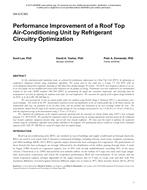Description
In this experiment-aided simulation study, we achieved the performance improvement of a Roof Top Unit (RTU) by optimizing an evaporator’s refrigerant circuitry using evolutionary algorithms. The system used in this study was a 2-stage 7.5 Ton RTU with an air-to-refrigerant finned-tube evaporator consisting of 144 rifled tubes divided amongst 16 circuits. The RTU was designed to operate as an airto- air heat pump, but was modified with water-cooled condensers for the purpose of testing. Performance tests were conducted in an environmental chamber in line with AHRI standard 340/360 (2007) by maintaining the liquid line saturation temperature and subcooling from the manufacturer’s test data by adjusting the condenser water flow rate and temperature. We measured the capacity of the original design included in the RTU to be 26.4 kW (90 100 Btu/h).
We also measured the in-situ air velocity profile under test condition using Particle Image Velocimetry (PIV), a non-intrusive, laserbased technique. The results of the PIV measurements uncovered several non-uniformities in the air velocity profile due to the blower location, the condensation drip tray, the placement of the air filter racks, and the position and orientation of the heat exchanger within the unit. The measurements showed that the range of air velocities passing through the heat exchanger varied from 0.5 m/s (1.64 ft/s) to 3.0 m/s (9.84 ft/s), with the integrated average of the measurements being 1.75 m/s (5.74 ft/s). We simulated the performance of the original evaporator operating with the measured air velocity profile using NIST’s heat exchanger program, EVAP-COND. We matched the simulation results to the measured data by selecting appropriate correction factors for the refrigerant heat transfer coefficient, refrigerant pressure drop, and air-side heat transfer coefficient. We then used this model to optimize the evaporator circuitry using the evolutionary algorithm based module embedded in the program. The optimization process resulted in a design with a simulated capacity of 28.5 kW (97 200 Btu/h), nearly 8% higher than the original design.
Product Details
- Published:
- 2013
- Number of Pages:
- 8
- File Size:
- 1 file , 1.4 MB
- Product Code(s):
- D-DA-13-C001
- Note:
- This product is unavailable in Russia, Belarus




